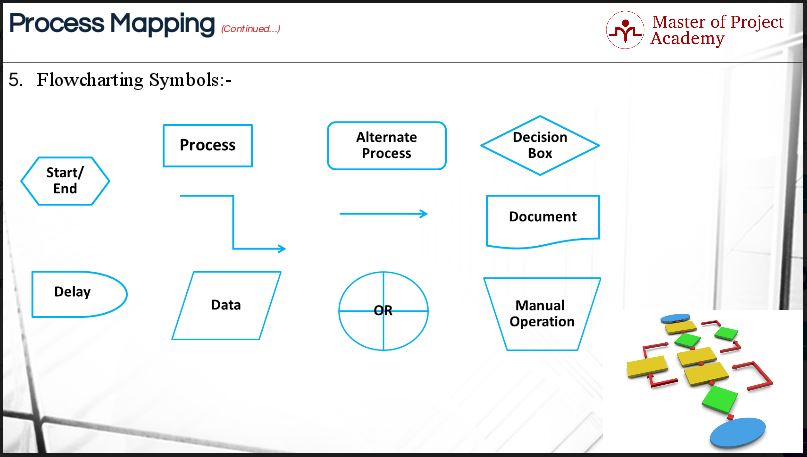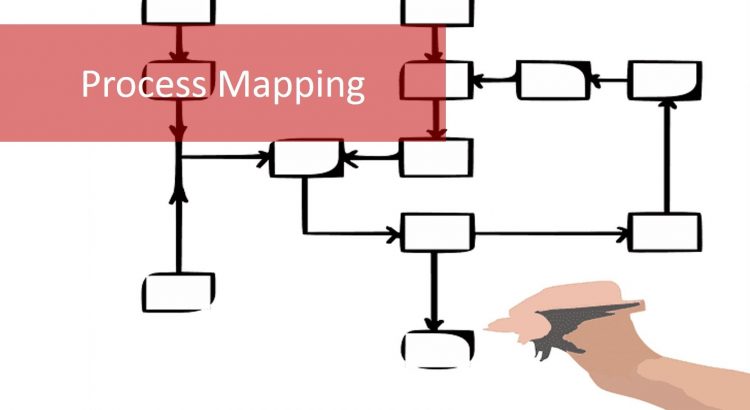There are many Six Sigma tools that are covered in Lean Six Sigma Green Belt training. One of the most important processes of the Six Sigma Define phase of the DMAIC cycle is Process Mapping. Process mapping is one of the fundamental Six Sigma principles that are shortly covered in free Six Sigma courses. But let’s start at the beginning and ask the most important question. Now let’s move on to Process Mapping Techniques.
Attend our 100% Online & Self-Paced Free Six Sigma Training.
What is Process Mapping Six Sigma?
The subject of process mapping and flowcharting is not new to all of us. Process mapping is one of the essential quality or process improvement tools used in LEAN Six Sigma. Process mapping is a workflow diagram to bring forth a clearer understanding of a process or series of parallel processes.
A process mapping has acquired more importance in recent times for the following reasons:
- The complexities of processes
- The need to capture and visualize knowledge that resides with the people who perform the task.
A process map, or flow chart, is a visual representation of a process that can illustrate:
- What activities are completed, by whom, in what sequence
- Hand-offs between departments or individuals
- Internal and external operational boundaries (swim lanes)
Process mapping can be constructed both informally and formally:
- The informal method is best for getting started and securing buy-in.
- The formal method ensures rigor and accuracy
Well-executed process mapping provides a process map that:
- Communicates process-related ideas, information, and data in an effective visual form.
- Identifies actual or ideal paths, revealing problem areas of risk and potential solutions
- Breaks a process down into steps using consistent, easily understood symbols
A structured approach to process mapping
Here’s the truth. Usually, process mapping is looked at as an activity in drawing some boxes and arrows and then filling up the boxes with some text. This generally ends in process maps that run into multiple pages, making it very hard to read and understand. Such process maps take too much time to modify too. Some ground rules can be applied to creating process maps; that make them easier to understand and use.
Using flowcharts
Let us now have a look at the process mapping techniques. The first method is known as Flowcharts. First and Foremost, you have to understand the fundamental difference between process maps and flowcharts. Process mapping is an act of drawing a flowchart, and the flowchart is merely a flowchart. The flowchart is also known as Process Flow Diagram, Functional flowchart, etc. Process mapping creates a picture of the separate steps of a process in sequential order. The process described can be anything: a manufacturing or non-manufacturing process and an administrative or service process. The underlying principle is that any process that can be charted or mapped can certainly be improved. Process mapping is the beginning of an improvement exercise!
There are 4 types of Flowcharts
- Document Flowchart: A document flowchart traces the movement of a document, such as internal memos, payroll information, and interoffice mail through a system. The chart consists of columns that are divided by vertical lines. Each column represents a section, employee, department or unit in a company. The flowchart shows how a document passes from one part of the business to another. Usually, document flowcharts contain minimal detail, just the route the document takes from one place to another
- Data Flowchart: A data flowchart illustrates how data pass through a system. Symbols indicate operations involved in the flow of data and the storage, input and output materials needed to keep the flow going. This is a good way to track where data originates and where it ends up. Data flowcharts are more concerned with the movement of the data than how the data is processed.

- System Flowchart: A system flowchart shows how an entire system works by demonstrating how data flows and what decisions are made to control this event. Symbols that connote decisions, processes, inputs, and outputs and data flow are the most important elements of a system flowchart. These differ from data flowcharts because they show decisions, which are more detailed. System flowcharts are used in fields such instances as aircraft control, central heating and automatic washing machines.
- Program Flowchart: A program flowchart demonstrates how a program works within a system. These flowcharts show any and all user-interaction pathways by using boxes and arrows. These arrows and boxes form hierarchical menus. Program charts can be large and complex. However, they are useful for mapping an entire program.
Written procedures
Let us now see the second process mapping technique. It is known as written procedures. A written procedure is a step-by-step guide to direct the reader through a task. Let us understand what the word ‘procedure’ means. Procedures are action oriented. They outline steps to take and the order in which they need to be taken. They are often instructional, and they may be used in training and orientation. Well-written procedures are typically solid, precise, factual, short, and to the point.
Not everything needs a procedure. Do not create procedures for basic tasks or else they will be ignored. The number-one rule of procedure writing is to make sure there is a reason to create them. Perhaps people forget to take certain actions, maybe they keep on getting things wrong, or perhaps tasks are so long and complicated that people need a checklist if they’re going to get things right.
A written procedure is necessary only if the issue is important or if there will be a significant benefit from clarifying a process. You need a written procedure when a process is lengthy, complicated and routine too. Even in a routine process, our objective of writing a procedure should be such that everyone has to follow the rules strictly.
Work Instructions in process mapping
The third process mapping technique is work instructions. Work instructions are normally ‘Level 3’ documents. Similar to written procedures, it describes how to perform a task. However, it is a more detailed portion of the procedure such as ‘Invoice checking’ that may include work instructions to aid in training, to reduce mistakes, etc.
Work instructions are very detailed on “HOW” to accomplish a particular job, task or assignment. For example, a work procedure could be developed for auditing the vendor invoice with step-by- step instructions including such detail as the type of invoice, invoice code, invoice reference number, duplicate invoice, etc.
Individual work instructions are particular to an industry or business. Supplementary documentation can be used including User’s Manuals, Engineering or Technical Manuals, Technical Support notes, Manufacturing Notes, etc., to create detailed work instructions.
Flowcharting process mapping symbols
When creating a flowchart during process mapping, it is very essential to be aware of flowcharting process mapping symbols. Without the knowledge of these symbols, we will not be able to draw a flowchart. Please note that flowcharts use special shapes to represent different types of actions or steps in a process. Lines and arrows show the sequence of the steps and the relationships among them. These are known as flowchart symbols and can effectively be used in process mapping.
This figure showcases a few of the flow-charting symbols that are normally used in process mapping. In Excel and PowerPoint 2010, all these and many more symbols are available under Insert – Shapes – Flowchart navigation. For the purpose of preparing a flowchart fluently and quickly during process mapping, we can also take the help of process mapping tools or software such as MS-Visio, MS-Project or BizAgi. These programs are used for process mapping, flowcharting and process modeling.

And that is how do process mapping. As you see, there are a variety of Process Mapping Techniques. The most popular way is to create a flowchart detailing all the steps that need to be taken. A proper process map does not only contain the what but also the who. With process mapping, it is easy to follow a difficult process. The processes that Six Sigma practitioners improve upon are usually complex and requires process mapping.
Review by: Ryan Mccoy



Nice post, thanks. I agree that process maps can often become too complicated and, as a result, end up sitting on a dusty shelf. As the old saying goes, “less is more”. We created a helpful guide on simple process mapping that you might find interesting: https://www.gluu.biz/simple-process-mapping/